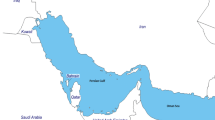Abstract
For the microwave region of the electromagnetic spectrum, unlike visible light, the imaginary part of the refractive index can be significant, in which case it cannot be neglected. A well-known empirical model is not available for the direct calculation of the complex refractive index of seawater at the microwave region. However, based on the relationship between the refractive index and the permittivity, and by using the models provided for the seawater permittivity at the microwave frequencies the refractive index can be calculated. In this work, complex refractive index and normal reflectivity of Persian Gulf water at the C-band (5 GHz) have been calculated by using electromagnetic equations. The complex permittivity required for computing these parameters has been calculated from the Ellison's empirical model with measured input data. Calculations showed that the annual mean of basin-averaged of real and imaginary parts of the refractive index is 6.074 and 0.415, respectively. The relative spatial and temporal variability of the imaginary part of the refractive index is considerably stronger than its real counterpart. In all seasons, the reflection coefficient at the nadir in the western half of the Gulf is slightly higher than the eastern half and it has a minimum value of 0.5230 over the southeast waters in the summer and a maximum value of 0.5250 over the northwest waters of the Gulf Persian in winter.









Similar content being viewed by others
References
Alosairi Y, Pokavanich T (2017) Seasonal circulation assessments of the northern Persian Gulf. Mar Pollut Bull 116(1–2):270–290
Buchner R, Barthel J, Stauber J (1999) The dielectric relaxation of water between 0 °C and 35 °C. Chem Phys Lett 306(1–2):57–63
Burnham C, Anick D, Mankoo P, Reiter G (2008) The vibrational proton potential in bulk liquid water and ice. J Chem Phys 128(15):154519
Carey DM, Korenowski GM (1998) Measurement of the Raman spectrum of liquid water. J Chem Phys 108(7):2669–2675
El-Nimri S (2010) Development of an improved microwave ocean surface emissivity radiative transfer model. Ph.D. thesis. Orlando, Florida: University of Central Florida
Ellison W (2007) Permittivity of pure water, at standard atmospheric pressure, over the frequency range 0–25 THz and the temperature range 0–100 °C. J Phys Chem Ref Data 36(1):1–18
Ellison W et al (2003) A comparison of ocean emissivity models using the Advanced Microwave Sounding Unit, the Special Sensor Microwave Imager, the TRMM Microwave Imager, and airborne radiometer observations. J Geophys Res. https://doi.org/10.1029/2002JD003213
Ellison W, Lamkaouchi K, Moreau J-M (1996) Water: A dielectric reference. J Mol Liq 68(2–3):171–279
Guillou C et al (1998) Impact of new permittivity measurements on sea surface emissivity modeling in microwaves. Radio Sci 33(3):649–667
Hale GM, Querry MR (1973) Optical constants of water in the 200-nm to 200-μm wavelength region. Appl Opt 12(3):555–563
Hassanzadeh S, Hosseinibalam F, Rezaei-Latifi A (2011) Numerical modelling of salinity variations due to wind and thermohaline forcing in the Persian Gulf. Appl Math Model 35(3):1512–1537
Hassanzadeh S, Hosseinibalam F, Rezaei-Latifi A (2012) Three-dimensional numerical modeling of the water exchange between the Persian Gulf and the Gulf of Oman through the Strait of Hormuz. Oceanol Hydrobiol Stud 41(1):85–98
Hosseinibalam F, Hassanzadeh S, Rezaei-Latifi A (2011) Three-dimensional numerical modeling of thermohaline and wind-driven circulations in the Persian Gulf. Appl Math Model 35(12):5884–5902
Locarnini RA, Mishonov AV, Antonov JI, Boyer TP, Garcia HE, Baranova OK, Zweng MM, Paver CR, Reagan JR, Johnson DR., Hamilton M, Seidov D (2013) World ocean atlas 2013, volume 1: Temperature. In: Levitus S (ed), Mishonov A (tech ed) NOAA Atlas NESDIS 73, pp 40
Meissner T, Wentz FJ (2004) The complex dielectric constant of pure and sea water from microwave satellite observations. IEEE Trans Geosci Remote Sens 42(9):1836–1849
Monahan EC, Woolf DK (1989) Comments on “Variations of whitecap coverage with wind stress and water temperature. J Phys Oceanogr 19(5):706–709
Nabokov O, Lubimov YA (1988) The dielectric relaxation and the percolation model of water. Mol Phys 65(6):1473–1482
Reitz J, Milford F, Christy R (2008) Foundation of electromagnetic theory, 4th edn. Addison Wiley, USA
Rezaei-Latifi A (2016) Spatial and temporal variability of the surface permittivity of Persian Gulf water at the C-band. Appl Math Model 40(2):1069–1081
Rezaei-Latifi A (2020a) Computation of the vertical and horizontal polarizations of brightness temperature of flat surface water over the Persian Gulf at the L-Band. Indian J Phys 94(3):293–301
Rezaei-Latifi A (2020b) Refractive index of Persian Gulf water in the visible portion of the electromagnetic spectrum. J Opt. https://doi.org/10.1007/s12596-020-00591-w
Segelstein D (1981) The complex refractive index of water, Master's thesis. University of Missouri
Simmonds E, Lamboeuf M (1981) Regional fishery survey and development project, Bahrain, Iran, Iraq, Kuwait, Oman, Qatar, Saudi Arabia, United Arab Emirates. Environmental conditions in the Gulf and the Gulf of Oman and their influence on the propagation of sound
Swift SA, Bower AS (2003) Formation and circulation of dense water in the Persian Gulf. JGeophys Res 108(C1):4–1–4–21
Taher M, Mohamed A, Al-Ali A (2012) Some ecological characteristics and ichthyofauna of surrounding Sammaliah Island. Abu Dhabi. UAE Basrah J Sci 30:31–49
Thoppil PG, Hogan PJ (2010) Persian Gulf response to a wintertime shamal wind event. Deep Sea Res Part A 57(8):946–955
Zasetsky AY, Khalizov A, Earle M, Sloan J (2005) Frequency dependent complex refractive indices of supercooled liquid water and ice determined from aerosol extinction spectra. J Phys Chem A 109(12):2760–2764
Zweng MM, Reagan JR, Antonov JI, Locarnini RA, Mishonov AV, Boyer TP, Garcia HE, Baranova OK, Johnson DR, Seidov D, Biddle MM (2013) World ocean atlas 2013, volume 2: Salinity. In: Levitus S (ed), Mishonov A (tech ed) NOAA Atlas NESDIS 74, pp 39
Author information
Authors and Affiliations
Corresponding author
Additional information
Publisher's Note
Springer Nature remains neutral with regard to jurisdictional claims in published maps and institutional affiliations.
Rights and permissions
About this article
Cite this article
Rezaei-Latifi, A. Modeling of the complex refractive index and reflectivity of flat surface water over the Persian Gulf at C-band. Model. Earth Syst. Environ. 6, 1877–1885 (2020). https://doi.org/10.1007/s40808-020-00797-8
Received:
Accepted:
Published:
Issue Date:
DOI: https://doi.org/10.1007/s40808-020-00797-8




